Agro-Chemical Performance of Fcv Exotic Hybrids in Mardan
Wajahat Ali*1, Kamran khan1, Abdul Qahar1, Muhammad Mehran Anjum2, Nawab Ali2, Muhammad Owais Iqbal2 and Hazrat Usman2
1Department of Agronomy, Faculty of Crop Production Sciences, Pakistan
2 The University of Agriculture, Pakistan
3Department of Agronomy, the University of Agriculture, Pakistan
Submission: September 10, 2017; Published: September 21, 2017
*Corresponding author: Wajahat Ali, Department of Agronomy, Faculty of Crop Production Sciences, Pakistan, Tel: 3145782057; Email: wajahatali_1993@outlook.com
How to cite this article: Wajahat A, Kamran k, Abdul Q, Muhammad M A, Nawab A, Muhammad O I, Hazrat U. Agro-Chemical Performance of Fcv Exotic 06 Hybrids in Mardan. Int J Environ Sci Nat Res. 2017;5(2): 555658. DOI: 10.19080/IJESNR.2017.05.555658
Abstract
To identify desirable tobacco hybrids for commercial cultivation, an experiment comprising of twelve flue cured Virginia tobacco genotypes, including one check variety, was conducted in Randomized Complete Block Design with three replications at the Tobacco Research Station, Khan Ghari, Mardan during the year 2014-15. Data was recorded on eight agronomical and two chemical parameters. Statistical analysis of the data was performed and the means were separated using the least significant difference (LSD) test. Analysis of variance revealed that the genotypes differed significantly for plant height, number of leaves plant-1, green leaf weight kg plot-1, green leaf number kg-1, cured leaf weight kg plot-1, cured leaf number kg-1, yield ha-1, nicotine percentage in the cured leaf, and reducing sugars percentage. PVH-2310, PVH-2248 and PVH-2233 excelled in performance for yield and quality related traits and may be used in future tobacco research programs. These three hybrids can be used as commercial cultivars in the area after multi-location test trials.
Keywords: FCV; Tobacco; Hybrids; Agro chemicals
Introduction
Tobacco (Nicotianatabaccum L.) belongs to the family Solanaceae is an annual, short day, and self-pollinated crop. It is one of the major sources of income in government revenues due to world wide acceptance by growers and users. Tobacco is grown as cash crop worldwide due to high economic return. In Pakistan, during 2010-11, tobacco was planted on 51,300 hectares with a total production of 102,800 tones. In Khyber Pakhtunkhwa where the agro climatic conditions are highly suitable for its cultivation, tobacco is planted on 32,500 hectares. The tobacco industry generated 58.3 billion rupees as indirect taxes. Khyber Pakhtunkhwa is the major tobacco producing province of Pakistan [1]. As far as the yield in Pakistan is concerned, it is higher than mostly tobacco growing countries of the world like China, India, Brazil, America and Greece. But when it comes to quality, our tobacco is inferior and do not fetch good price in international market [2]. Next to sugarcane and sugar beet, tobacco is the major source of income to farmers in the Peshawar valley. Peshawar, Mardan, Hazara and some parts of Malakand Agency are among the largest tobacco producing areas. Tobacco is cultivated on small area (0.27%) of the total irrigated land in Pakistan [3].
Numerous types of tobacco are defined by different criteria such as region of production, intended use in cigar (i.e., filler, binder and wrapper) and cigarette manufacturing, method of curing (flue-, air-, sun- and fire-cured tobacco) as well as morphological and biochemical characteristics (i.e., aromatic fire-cured, bright leaf tobacco, Burley tobacco, Turkish or oriental tobacco) [4]. Various biochemical traits like nicotine content and reducing sugars affect the quality of tobacco. Genetic variability among burley tobacco genotypes for yield and quality traits has previously been reported many researchers [5]. Tobacco is grown for its leaves i.e., vegetative portion. Greater leaf yields depend on number of harvestable leaves, leaf length, breadth and weight. Leaf quality is also measured by grade index and quantities of nicotine and reducing sugar contents. Phenotypic expressions of quantitative traits are genotype and environment specific.
Evolution of high yielding tobacco varieties and improvement in leaf quality will fetch high profit to the growers and will enhance exports of tobacco and its products. To improve the yield of tobacco, it is imperative to know the important plant characteristics such as plant height, total number of leaves plant-1, cured leaf yield and total yield of different genotypes. Keeping in view the need and importance of high performance varieties, the present study was conducted to evaluate the tobacco variety having the potential to produce higher yielding and best quality in agro-climatic condition of Mardan with the following objectives.
a) To evaluate the overall performance of FCV exotic tobacco hybrids.
b) To identify the most prominent yield hybrid of FCV exotic tobacco.
c) To identify variety/hybrid that has the best nicotine and reducing sugar level.
Materials and Methods
Genotypic evaluation of twelve flue-cured Virginia tobacco hybrids including one check cultivar (SPT-G-28) was carried out at Tobacco Research Station, Khan Ghari, Mardan during the year 2014-15 (Table 1). First nursery was raised and for this purpose sowing was done in December, 2014. Transplantation was carried out in 3rd week of April, 2015. The experiment was laid out in Randomized Complete Block Design (RCBD) with three replications. All twelve hybrids were planted in 5 rows plot- 1and with ten plants row-1. Row-to-row distance of 90 cm and plant to plant distance 60 cm was used. Nitrogenous, phosphatic and potash fertilizers (NPK) was applied in the ridges before transplantation at the rate of 15: 15: 15 ha-1. All the agronomic practices was kept uniform for all hybrids included in the said study.
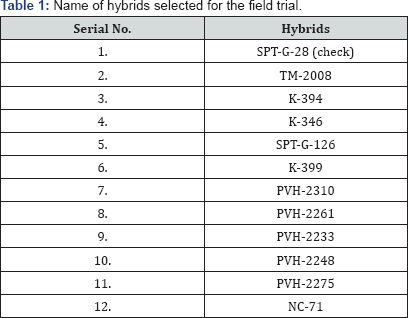
a) Plant height (cm): Data on plant height (cm) was recorded with the help of meter rod by selecting ten plants randomly from each plot plant height was measured form soil surface to the tip of the buds and then average was worked out.
b) Number of leaves plant-1: Data on number of leaves plant-1 was recorded by selecting ten plants randomly in each plot and counting the leaves of plants from the bottom to the tip of the main stock. Calculation was made for an average value.
c) Leaf area (cm2): Leaf area per plant was calculated by measuring the length and width of the 5th, 10th and 15th leaves of ten representative plants from the plot of each treatment. The mean single leaf area per plant was calculated by computing the following formula.
Leaf area = Leaf length x Leaf width x 0.644
d) Number of green leaves kg-1: For leaf number kg-1, one kilogram of leaves of each entry was weighed and then number of leaves was counted.
e) Green leaves weight kg plot-1: The green leaves were picked in each plot and then was weighted in order to calculate the green weight of leaves kg -1.
f) Number of cured leaves kg -1: Cured leaves of each plot was collected and counted. One kilogram of leaves of each treatment was weighed and then number of cured leaves was counted.
g) Cured leaves weight kg plot-1: The cured leaves were weighted in order to calculate the cured weight of leaves kg-1
h) Leaf yield (kg ha-1): The leaf yield kg ha-1 was calculated by the following formula.

i) Nicotine %: Nicotine content was calculated by the following formula as used by [6]

j) Leaf reducing sugar (%): Reducing sugars % was estimated as follow.

Statistical Analysis
The data was statistically analyzed according to Steel, 1996. For randomized complete block design and means among different treatment was composed using least significant differences (LSD) test (P ≤ 0.05).
Results and Discussion
Plant height (cm)
Plant height is directly related to the number of leaves that are emerged on a tobacco plant, hence the character may be used as an indicator for the potential number of leaves. Analysis of variance revealed highly significant differences (P<0.01) among the genotypes for plant height (Table 1). Plant height averaged was ranged from 118.6 to 141.4 cm. The highest plant height (141.4 cm) was recorded for PVH-2248 while shortest plants (118.1cm) were observed for genotype K-399, K-346, SPT-G-126 at Mardan. While check variety SPT-G-28 recorded plant height of 121.7 cm. Results further reveled hybrids TM-2008, K-394, PVH-2261, PVH-2233 and NC-71 were statistically at par. The variation in plant height could be due to the response of these hybrids to environmental conditions or genetic make-up of these FCV tobacco hybrids. These findings are in accordance with those of [7,8] observed significant differences among tobacco genotypes for plant height.
Number of leaves plant-1
Number of leaves plant-1 is one of the major yield components of a tobacco genotype [9]. Usually high prices are offered for long and broad leaves. Plant having more number of leaves directly means that it will have more yields provided the leaves are not too small. Highly significant differences (p< 0.01) among the tobacco genotypes were observed for number of leaves plant-1 (Table 2). Number of leaves plant-1 among FCV hybrids varied between 23 and 27.3. PVH-2310 recorded highest number (27.3) of leaves plant-1 followed by PVH-2275 with 26.3 leaves plant-1. While check variety SPT-G-28 recorded mean (24.6) leaves plant-1. Results further indicate hybrids (K- 399, TM-2008 and NC-71) were statistically identical. Lowest number of leaves plant-1(23) was observed for SPT-G-126 among tested the hybrids. These results are in agreement with those of [10,11]. These researchers also reported significant genetic variation among tobacco genotypes for number of leaves.
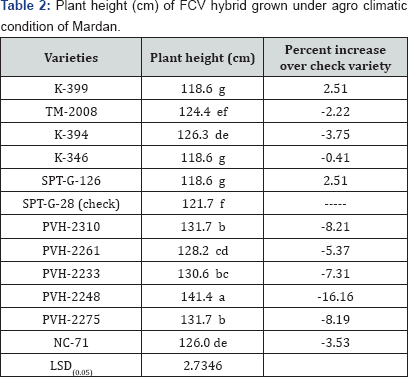
Leaf area plant-1 (cm2)
Leaf area is one of the major yield components of a tobacco genotype [12]. Data concerning leaf area plant-1 showed in (Table 3) . Analysis of the data showed significant differences among the tested hybrids. Mean value of data displayed that leaf area plant-1 ranged from 678.5 to 1003.4 cm2 among the FCV tobacco hybrids. Maximum leaf area (1003.4 cm2) plnat-1 was obtained for PVH-2310 followed by PVH-2348 with a leaf area of (955.7 cm2). PVH-2310 produced 47.6 percent more leaf area plant-1 compared to check variety SPT-G-28 with leaf area of 679.6 cm2. Statistical analysis revealed no similarity among hybrids for leaf area plant-1. Minimum leaf area (678.5 cm2) plant-1 was observed for K-399. Significant genetic differences among the tobacco genotypes for leaf area as observed in the present study is compatible with the findings of [13,14].
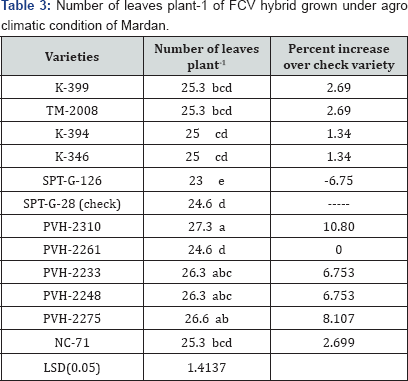
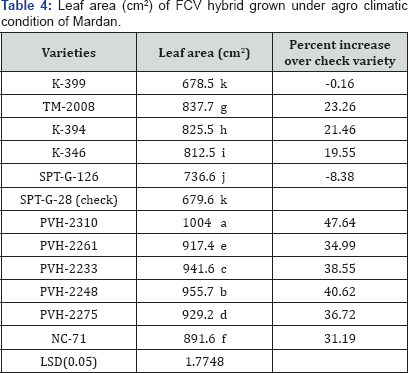
Number of Green leaves kg-1
Green leaves yield is an important characteristic of tobacco crop which not only determines the cured leaf yield potential of a particular genotype but also affects the cost of curing green leaf [15]. Statistical analysis, revealed significant differences (P>0.05) among the genotypes for green leaf number kg-1 (Table 4) . Mean data manifested that the green leaf number kg-1 among the hybrids ranged from 21.3 to 50 (Table 2). K-399 had maximum number of green leaves (50) in one kg closely followed by TM- 2008 with 49.6 green leaves kg-1. Results showed that all the FCV tobacco hybrids were statistically similar in production of green leaves kg-1 except K-394 and K-346. Check variety SPT-G-28 obtained 48.3 leaves kg-1. K-346 recorded less number (21.3) of green leaves kg-1. These results are in agreement with [16] who found significant differences among genotypes for green leaves kg-1, which might be due to the variation in genetic material and changes in ecological conditions.
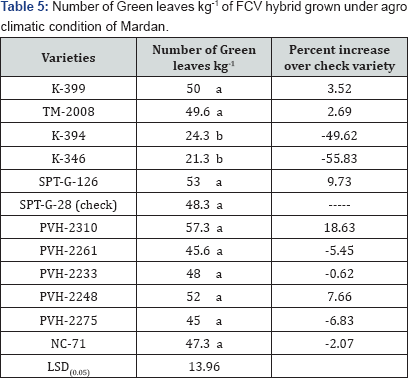
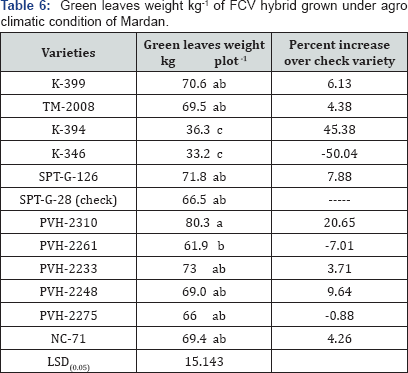
Green leaves weight kgplot-1
The results revealed significant differences among FCV tobacco hybrids mean for green leaves kg plot-1 (Table 5). Data for green leaves weight varied from 33.2 to 80.3 kg plot-1. Higher green leaves weight plot-1 was recorded for PVH-2310 followed by PVH-2233 with green leaves weight of 73 kg plot-1.Check variety SPT-G-28 was statistically similar with hybrids K-399, TM-2008, SPT-G-126, PVH-2233, PVH-2245, PVH-2275 and NC- 71. Lowest green leaves weight 33.2 kg plot-1 was observed for K-346 that was closely followed by K-394 with 36.3 kg lowest green leaves weight plot-1. These results are contrary to the findings of [17] who found non-significant differences among genotypes for green leaves kg plot-1, but are in agreement with [18] who found significant differences for leaf related characters among various genotypes (Table 6).
Number of Crude leaf kg-1
Cured leaf number kg-1 is an important component which determines the yield potential of tobacco hybrids. Highly significant differences (P<0.01) among the FCV tobacco hybrids for cured leaf number kg-1 were observed (Table 7). Range of cured leaves kg-1 among the hybrids was from 115 to 140. K-399 produced significantly maximum cured leaf yield followed by SPT-G-126 with 126 cured leaves kg-1. Check variety SPT-G-28 was statistically similar for cured leaves kg-1 to the hybrids TM- 2008, SPT-G-126, PVH-2261, PVH-2275 and NC-71 that are included in the study. The lowest cured leaves 115 kg-1 was noted in PVH-2310 closely followed by K-394 with 116 cured leaves 115 kg-1. The difference in the above mentioned character of hybrids under study might be attributed to difference in their genetic constitution. These results are in agreement with the finding of [19,20] who also reported significant genetic variation among tobacco genotypes for this trait.
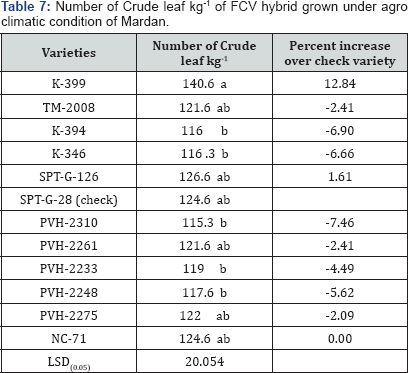
Crude leaves weight kgplot-1
Cured leaves weight is one of the most important plant characteristics in tobacco crop as it is directly related to farmer's profit. It is the final product of tobacco crop after passing the green leaves through different curing procedures. Highly significant differences (p<0.01) among the hybrids were observed for cured leaves weight kgplot+ (Table 8). Data for cured leaf weight ranged from 12.4 to 5.3 kg plot+ for hybrids. Tobacco hybrid PVH-2310 exhibited superiority for this important plant characteristic followed by NC-71 with 11.6 crude leaves weight kgplot-1. Check variety SPT-G-28 produced 10.4 kg crude leaves plot-1 and was statistically identical with that of K-399, TM-2008, SPT-G-126, PVH-2233, PVH-2248, PVH- 2275 and NC-71. Lower crude leaves weight (5.3) kgplot-1 was recorded in plot of K-346 followed by K-394 with crude leaves weight of 5.8 kgplot-1. These results are in agreement with the finding of [21,22] also reported significant genetic differences among the tobacco genotypes for cured leaves weight kgplot-1.
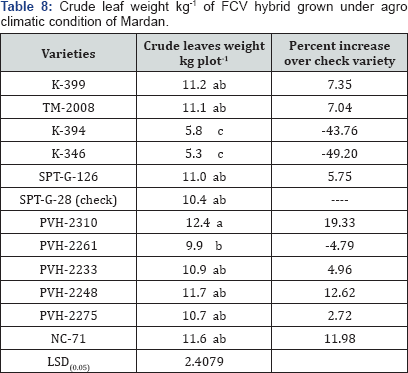
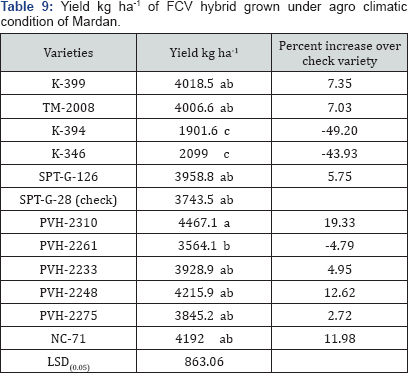
Yield kg ha-1
Yield is the final important character of plant, which is directly associated with the earnings of the growers. More yields mean more profit. Highly significant differences (P<0.01) among the hybrids were observed for yield kg ha-1 (Table 9). The value for this trait among the hybrids varied between 1901.6 kg and 4467.1 kg ha-1. Hybrid PVH-2310 had maximum yield (4467.1 kg ha-1) followed by PVH-2248 with cured leaf yield of 4215 kg ha-1. Check cultivar Spt G-28 produced cured leaf yield of 3743.5 kg ha-1 and were statistically at par with that of TM- 2008, SPT-G-126, PVH-2233, PVH-2248, PVH-2275 and NC-71 whereas, the lowest yield of 1901.6 kg ha-1 was recorded for K-394. Tobacco hybrids PVH-2310 and PVH-2248 thus excelled in performance for yield kg ha-1. These results are in line with the study of [23,24] who recorded significant genetic differences among the tobacco genotypes for yield kg ha-1.
Percent leaf Nicotine
Nicotine is an alkaloid, which only exists in tobacco plants, and accounts for 95% of its total alkaloid content [25]. It is the principal chemical in tobacco defining tobacco quality Shmuk, 1953. Higher contents of nicotine negatively affect different physiological while very low contents offer no satisfaction to the smoker. The hybrids exhibited significant differences (P<0.05) for the nicotine content of their leaves (Table 9). Nicotine content among the hybrids varied from 1.8 to 2.7%. TM-2008 had leaves of maximum nicotine content of 2.7% and was closely followed by K-399, K-394 with percent leaf nicotine of 2.6. Check variety SPT-G-28 showed a decrease in nicotine percentage recorded 2.5% nicotine content, and were found to be statistically at par with that of SPT-G-126 and PVh-2310. Whereas K-394 recorded minimum nicotine of (1.8%) in its leaves. Hybrid differences among cured tobacco leaves for nicotine percentage have also previously been reported by Triplat et al. [26,27].
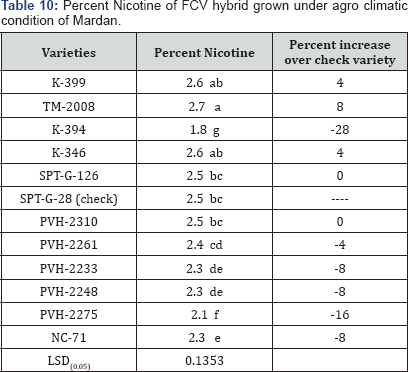
Reducing sugars
Reducing sugars exercise the most favorable influence on the tobacco taste and aroma during smoking and are one of the most important quality parameters of flue-cured tobacco. Its higher contents impart sweetness to aroma Hashmi et al. [28]. Highly significant differences (p<0.05) among the hybrids were observed for reducing sugar percentage in the leaves (Table 10). Reducing sugar contents in the leaves of tobacco hybrids ranged between 14.3 and 20.3 (Table 11). SPT-G-126 displayed minimum value (14.3) for this trait, whereas PVH-2233 had maximum value (20.3) for reducing sugar content of all hybrids used in study. Check variety SPT-G-28 leaves was observed with 16.9 reducing sugar content and found to be statistically same with that of PVH-2310. Hybrid K-399, K-394 and PVH-2275 was also statistically identical but different from Check variety SPT-G-28. PVH-2233 thus manifested its superiority for reducing sugars content. These results are compatible with the findings of shah et al. [29] and Pathak et al. [30]. They also reported significant genetic differences among tobacco genotypes for this trait [31-36].
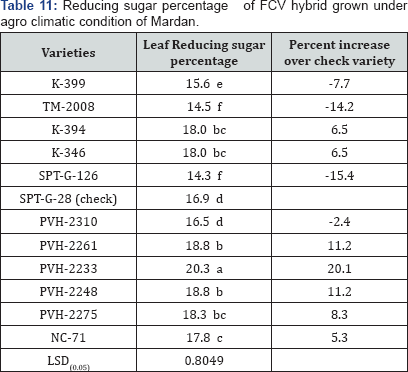
Conclusion and Recommendation Conclusion
Conclusion
Keeping in view the good performance of PVH-2310 and PVH- 2248 for agronomical and chemical characters, it is suggested that these two exotic FCV hybrids can be grown in Mardan region in order to boost the economy from tobacco cultivation as these hybrids are high yielding as compare to check variety "SPT-G-28" and other hybrids of FCV tobacco included in the trial.
Recommendation
It is therefore recommended thatPVH-2248 and PVH-2310 should be considered for general cultivation under agro-climatic condition of Mardan, region.
References
- Ahmad Q, F Mohammad (2014) Yield attributing traits in parents versus hybrids in FCV Tobacco (Nicotianatabacum L). Sarhad journal of agriculture 30(2).
- Badshah H, A Wajid, M Saeed, H Ullah, F Ullah, et al. (2013) Screening of elite tobacco (NicotianaTabacum L) genotypes for their physiological traits and resistant to tobacco bud worm (Eeliothisvirescensf). Pak J Bot 45(2): 671-675.
- MINFAL (2007) Agricultural Statistics of Pakistan 2005-06 Ministry of Food, Agric and Livestock. Food, Agric and Livestock Div, Govt of Pakistan, Islamabad, Pakistan, pp. 278.
- REN N, TIMKO MP (2001) AFLP analysis of genetic polymorphism and evolutionary relationships among cultivated and wild Nicotianaspecies. Genome 44(4): 559-571.
- Butorac J (2000) Heterosis and Combining ability of certain chemical traits in Burley tobacco. RostlinnaVyroba 46(5): 219-224.
- Idrees QM and S Khan (2001) Effect of different seedling size and NPK doses of fertilizer on the yield and quality of flue-cured Virginia tobacco (Nicotianatabaccum L) MSc Thesis, Agronomy Department, NWFP Agricultural University, Peshawar, Pakistan.
- Maleki HH, G Karimzadeh, R Darvishzadeh and A Sarrafi (2011) Correlation and sequential path analysis of some agronomic traits in tobacco (NicotianatabaccumL) to improve dry leaf yield. Aus J Crop Sci 5(12): 1644-1648.
- Shah SM, AA Ahmad, F Mohammad, HU Rahman, G Woras, et al. (2008) Genotypic evaluation of some FCV TOBACCO genotypes for yield and quality traits. Sarhad J Agric 24(4).
- Woras G, EA Hashmi, MZ Qazi, B Ali, M Zaman, et al. (1989) Varietal performance some Virginia tobacco (Nicotianatabacum L) cultivars. Pak Tob 13(2): 7-13.
- Butorac J, J Beljo and J Gunjaca (2004) Study of inheritance of some agronomic and morphological traits in burley tobacco by graphic analysis of diallel cross. Plant Soil Environ 50(4): 162-167.
- Sadeghi SM, E Amin and M Ashouri (2012) An investigation of gene action on different traits of tobacco under irrigated and drought stress environment. African J of Biotech 11(21): 4740-4751.
- Hashmi EA, G Woras, F Karim, M Shahid and SA Shah (2004) Comparative study of different flue-cured Virginia (FCV) tobacco varieties in NWFP and quality of flue-cured Virginia tobacco Nicotiana Pakistan. Pak Tob 23(1): 18-20.
- Butorac J, Z Mustapic and J Beljo (1995) Major morphological properties of some burley tobacco genotypes. Bodenkultur 46(4): 321-329.
- Liu FL, Y Li, SQ Wang and HY Song (1999) Comparison of characteristics of 7 flu-cured tobacco cultivars. J Henan Agric Sci 11: 13-15.
- Hashmi EA, G Woras, MZ Qazi (1985) Performance of some flue-cured tobacco (Nicotianatabacum L) genotypes at Mardan (NWFP). Pak Tob 9(l&2): 11-14.
- Ahmad S, F Mohammad, Q Ahmed, MAU Khan (2014) Assessing genetic variation for Morpho-Agronomic Traits of some native and exotic FCV Tobacco genotypes in Pakistan. American-Eurasian J Agric & Environ Sci 14(5): 428-433.
- Shah SMA, F Ullah, HU Rahman, MY Khan, M Sohail, et al. (2009) Acclimatization of Burley Tobacco Germplasm under agro-ecological condition of swat valley. Sarhad J Agric 25(1).
- Butorac J, J Beljo and J Gunjaca (2004) Study of inheritance of some agronomic and morphological traits in burley tobacco by graphic analysis of diallel cross. Plant Soil Environ 50(4): 162-167.
- Rao GSBP (1998) Breeding for yield and quality improvement of flue- cured Virginia tobacco. Tob Res 24(1): 9-14.
- Malik IA (1980) Evaluation of air-cured varieties of Nicotianatabacum L for certain agronomic chemical and quality characteristics and their feasibility in tobacco production. Pak Tob 4(2): 9-13.
- Dimitrova S (1998) Agro biological characteristics of oriental tobacco variety Ticha 117. RastenievdniNauki 35 (5): 375-379.
- Hanoomanjee P, JA Lalouette, DY Bachraz, N Sukurdeep and BD Seebaluck (1998) Performance testing of some fluecured tobacco varieties in recent years. Proc 2nd Annual Meeting Agric Scientists, Reduit, Mauritius pp.161-165.
- Sadeghi SM, E Amin and M Ashouri (2012) An investigation of gene action on different traits of tobacco under irrigated and drought stress environment. African J of Biotech 11(21): 4740-4751.
- Ali IA Muhammad, H Raza, AU Rehman, IU Khaliq (2014) Performance of flue cured virginia tobacco. International Journal of Basic & Applied Sciences IJBAS -IJENS 14(02): 140402-145757.
- Woras G, EA Hashmi, MZ Qazi, B Ali, M Zaman, et al. (1989) Varietal performance some Virginia tobacco (Nicotianatabacum L). Cultivars Pak Tob 13(2): 7-13.
- Triplat J, J Beljo and J Butorac (1994) New Burley tobacco varieties for growing conditions in Croatia. Poljoprivredna Znanstvena Smorta 59(2&3): 195-201.
- Kara SM and E Esendal (1995) Heterosis and combining ability analysis of some quantitative characters in Turkish tobacco. Tob Res 21(1-2): 16-22.
- Hashmi EA, FM Khan, MZ Qazi, G Woras and SA Shah (1990) Evaluation of sun- cured varieties of Nicotianarustica L. for certain agronomic and chemical characteristics at Mardan. Pak Tob 15(1): 5-9.
- Woras G, EA Hashmi, F Karim, M Shahid, and SA Shah (2004) Comparative evaluation of some tobacco varieties (Nicotianarustica L). Pak Tob 23(1): 10-11.
- Pathak HC, JN Patel, GC Jadeja, R Lakshminarayana and SB Patel (1996) Line x tester analysis for yield and quality in tobacco (Nicotianatabacum L). Tob Res 22(1):7-13.
- Anonymous (2005) Area under cultivation of different crops in Pakistan. Agriculture Statistics of Pakistan, pp. 38.
- Badshah H (2005) Tobacco in general types, growing areas and its production. LTC Report II: 7-25.
- Bakht J, Azra and M shafi (2012) Antimicrobial activity of Nicotianatabacum using different solvents extracts. Pak J Bot 44(1): 459-463.
- Hasani S, HA Pirdashti, R Mesbah and NA BabaeyanJolodar (2008) Study effects of different nitrogen and potassium fertilizers application amounts on quantitative and qualitative characteristics of tobacco (male sterile variety, PVH 19). Journal of sapling and seed 24: 45-52.
- Idrees QM, and S Khan (2001) Effect of different seedling size and NPK doses of fertilizer on the yield and quality of flue-cured Virginia tobacco (Nicotianatabaccum L). MSc (Hons) Thesis, Agronomy Department, NWFP Agricultural University, Peshawar, Pakistan.
- Steel RGD, JH Torrie and D Dickey (1996) Principals and Procedures of Statistics. McGraw Hill, USA. 1996.






























